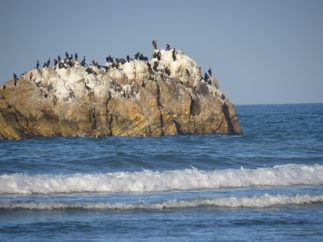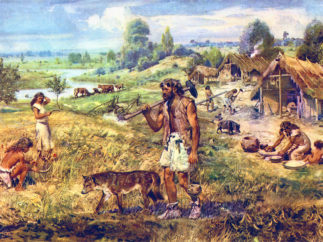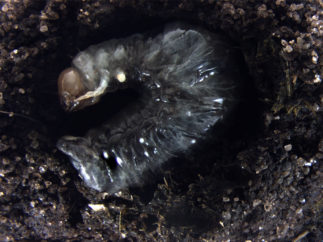Human societies have become a ‘great force of nature’. Among the many massive environmental changes we are causing are the widespread conversion of habitats to agricultural fields and settlements, species extinctions, global climate change, and the pollution of air, land and sea. So profound are these global transformations that geologists may soon recognise them as the start of a new epoch of geologic time, the Anthropocene.
Defining niche construction
Scientists like to define their terms. They believe that it is imperative to pin down key concepts so as to remove ambiguity as to what they mean, and how they are bounded. Definitions, it is argued, facilitate clear thinking and consensual analysis across scientific communities. Philosophers of science, on the other hand, who prize clear thinking, are frequently sceptical as to whether definitions truly fulfill this function. The trouble is that there is an infinite regress associated with definitions. For instance, the question ‘What is an innovation?’ might elicit a definition ‘a new idea, method or invention’, which invites the corollary question ‘What is an invention?’, in a recursion that could be pursued ad infinitum. What this means in practice is that definitions tend to have a fuzzier existence than most scientists might like to believe. Readers often possess subtly different understandings of a term’s meaning. One reason for this is that it is impossible to anticipate all new findings: think, for example, of the extraordinary complexities that have been discovered about the relationship between DNA base pair sequence and the construction of amino acid chains, and how those discoveries stretched earlier molecular definitions of gene. Definitions can’t pin concepts down in any absolute sense, nor remove all ambiguity, although they can and do help scientists to communicate. Does that mean that scientists are wasting their time searching for definitions? No. Definitions fulfill an important function by guiding research programs. The question to ask when defining a concept is ‘What job do we want it to do?’
Domestication as a model system for the Extended Evolutionary Synthesis
Archaeology has a long history of looking to evolutionary biology for ways to explain the initial domestication of plants and animals. To date, most have been firmly grounded in traditional neo-Darwinian principles. These characterize domestication as an adaptive response to declining resource availability in which human goal-directed behavior plays little if any role. Recently, many of us have begun to look to niche-construction theory (NCT) as an alternative framework that achieves a much better fit with the empirical record of initial domestication in multiple world areas and also aligns with our recognition of the importance of human agency and goal-directed behaviors in evolution1,2. As archaeologists have become more familiar with the NCT literature, and the broader EES framework of which NCT is a part, we have recognized that we, in turn, have something to offer evolutionary biologists. One of the major challenges to the EES is to demonstrate that it can generate empirically testable, novel predictions about evolutionary processes3. The initial domestication of plants and animals, we argue, may help address this challenge. Indeed, we believe it answers Schlichting and Wund’s4 call for a gold standard ‘single system’ combining multiple interacting constructive processes and inheritance systems that can be used to comprehend complex evolutionary processes. Moreover, the increasingly robust archaeological, archaeobiological, and genetic (modern and ancient) data on initial domestication in multiple world areas makes it an especially tractable system for evaluating EES predictions.
Who’s afraid of the Extended Synthesis?
"A new scientific truth does not triumph by convincing its opponents and making them see the light, but rather because its opponents eventually die, and a new generation grows up that is familiar with it." So wrote physicist Max Planck, in his Scientific Autobiography and Other Papers, (1949, pp. 33–34). That's a bit drastic, perhaps, but there definitely is a kernel of truth in what Planck stated. Of course, if you happen to be on the other -- conservative, shall we say -- part of any given scientific debate you will turn to a very different sort of quote for solace, like this one perhaps: "The fact that some geniuses were laughed at does not imply that all who are laughed at are geniuses. They laughed at Columbus, they laughed at Fulton, they laughed at the Wright brothers. But they also laughed at Bozo the Clown" (Carl Sagan, talking about pseudoscience, in Broca's Brain, 1979, p. 64).
What animal social learning can teach evolutionary biology
In November, a colloquium of the National Academy of Sciences, entitled The Extension of Biology through Culture, celebrated a coming of age of animal social learning research. The meeting, co-organised by ourselves, Marcus Feldman and Francisco Ayala, was a striking testament to how far the study of animal culture has come in recent decades and the truly remarkable set of findings uncovered (footage of several of the talks are available here and here). Speaker after speaker described compelling evidence for social learning being central to the lives of diverse animals, including apes, monkeys, whales and dolphins, birds, fishes, insects and of course, humans. Culture (at least, broadly conceived as the social transmission of learned knowledge) can no longer be construed as the exclusive province of humanity. Social transmission is a major means by which many animals adjust to, and exploit, their environments; a revelation with important implications for evolutionary biology.
Ecological development and adapting to change
As in many reptiles, the sex of leopard geckos is determined not by chromosomes, but by the environment. Hatchlings will develop into either males or females depending on the temperature they experience as incubating eggs. Sex isn’t hard-wired because the key genes involved in gonad differentiation are up- and down-regulated by temperature, so a fairly warm nest will produce mostly males, a cool nest mostly females, and a nest close to the temperature threshold, an evenly mixed brood.
Mum’s microbes are important for dung beetle development
An animal’s microbes not only help it to digest food, absorb nutrients and fight disease, they are also important during normal development. Researchers at Indiana University have shown that the collection of microbes passed from a beetle mother to her offspring (the maternal microbiome) is critically important for development of beetle larvae and their resistance to environmental challenges. The study, led by evolutionary developmental biologists, Daniel Schwab and Armin Moczek, focused on the dung beetle species, Onthophagus gazella.






